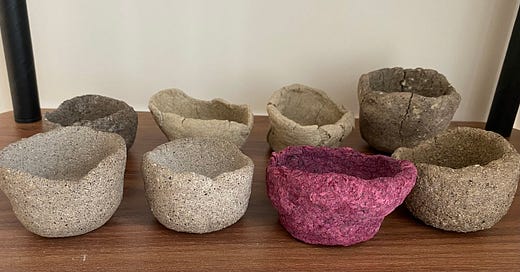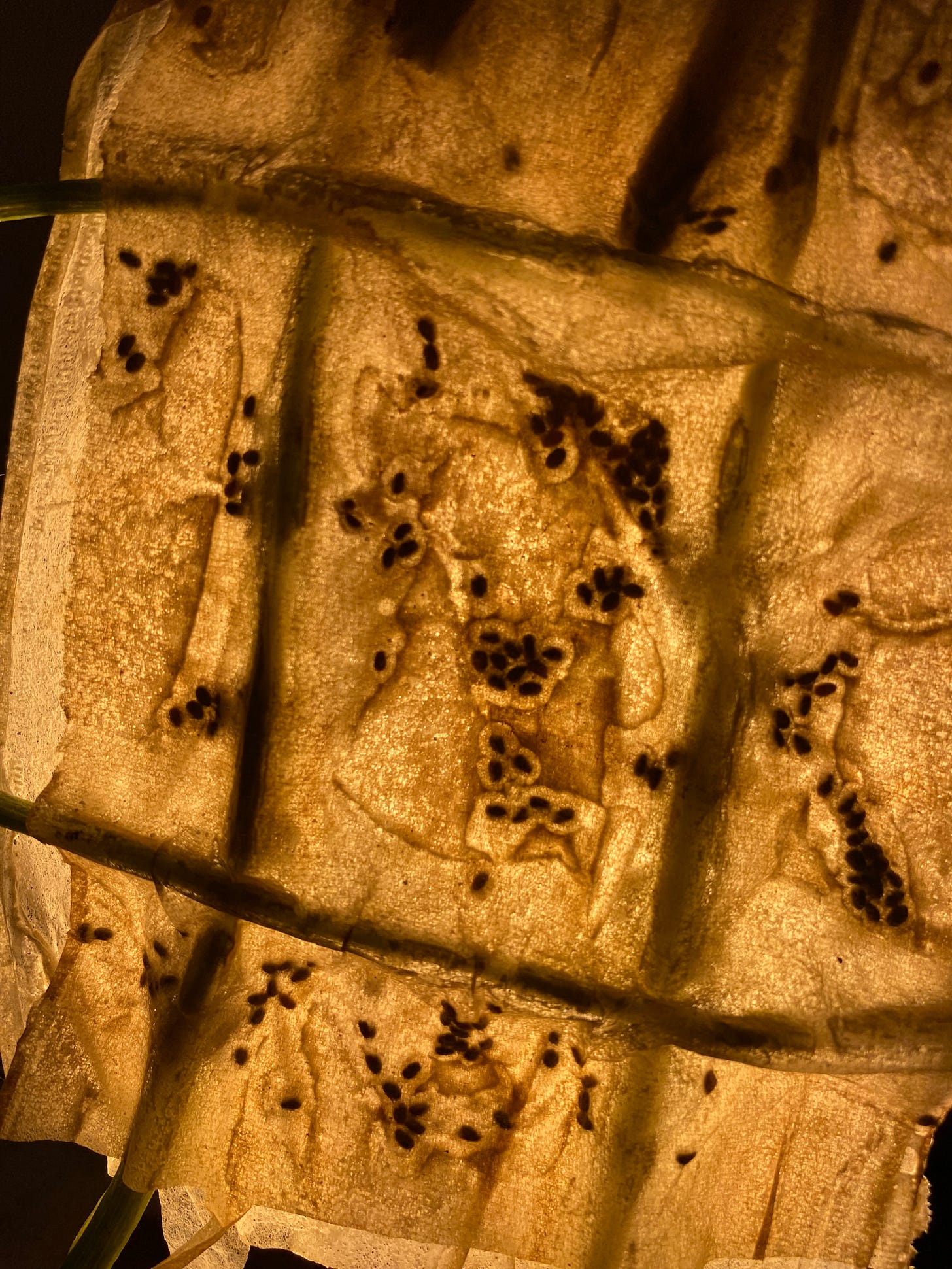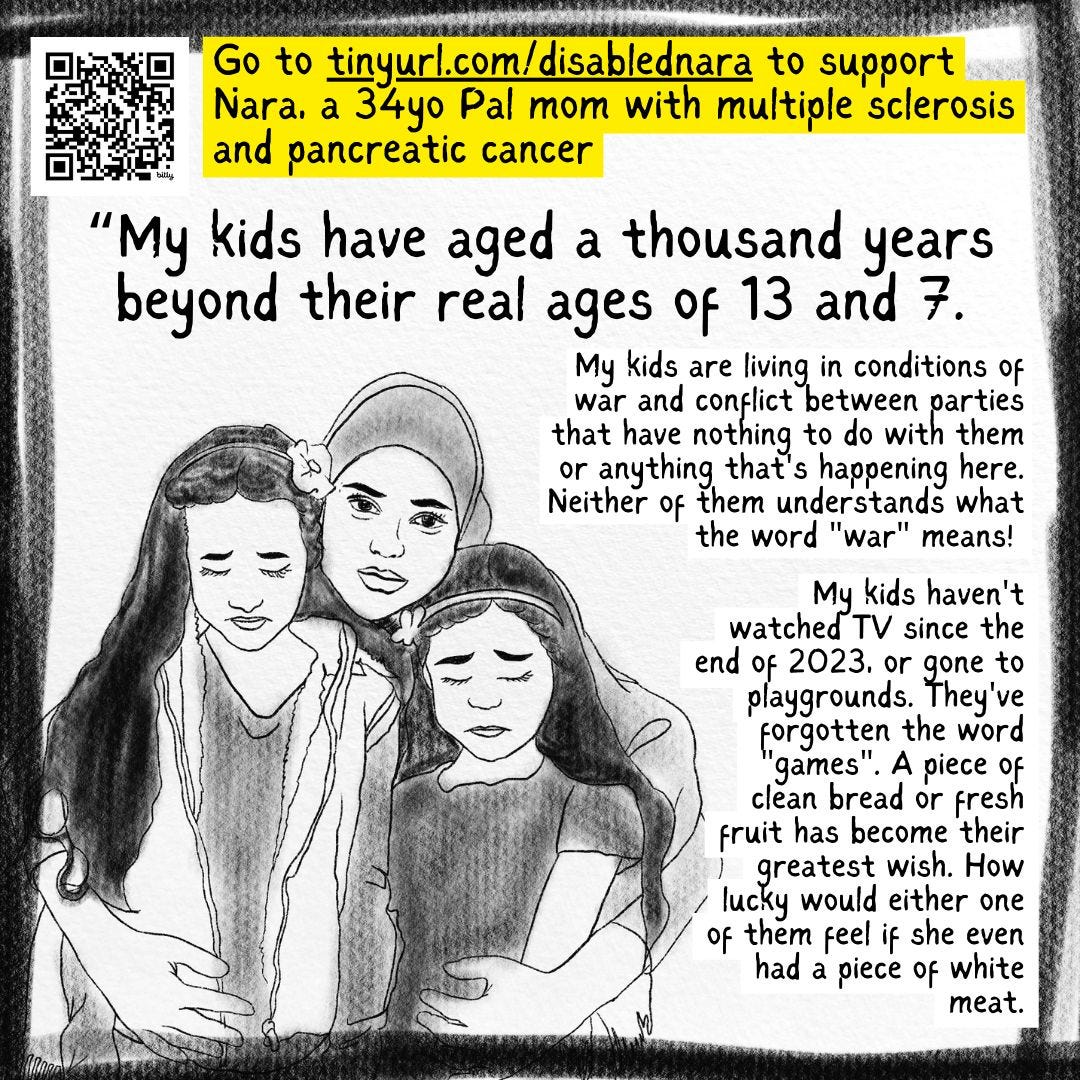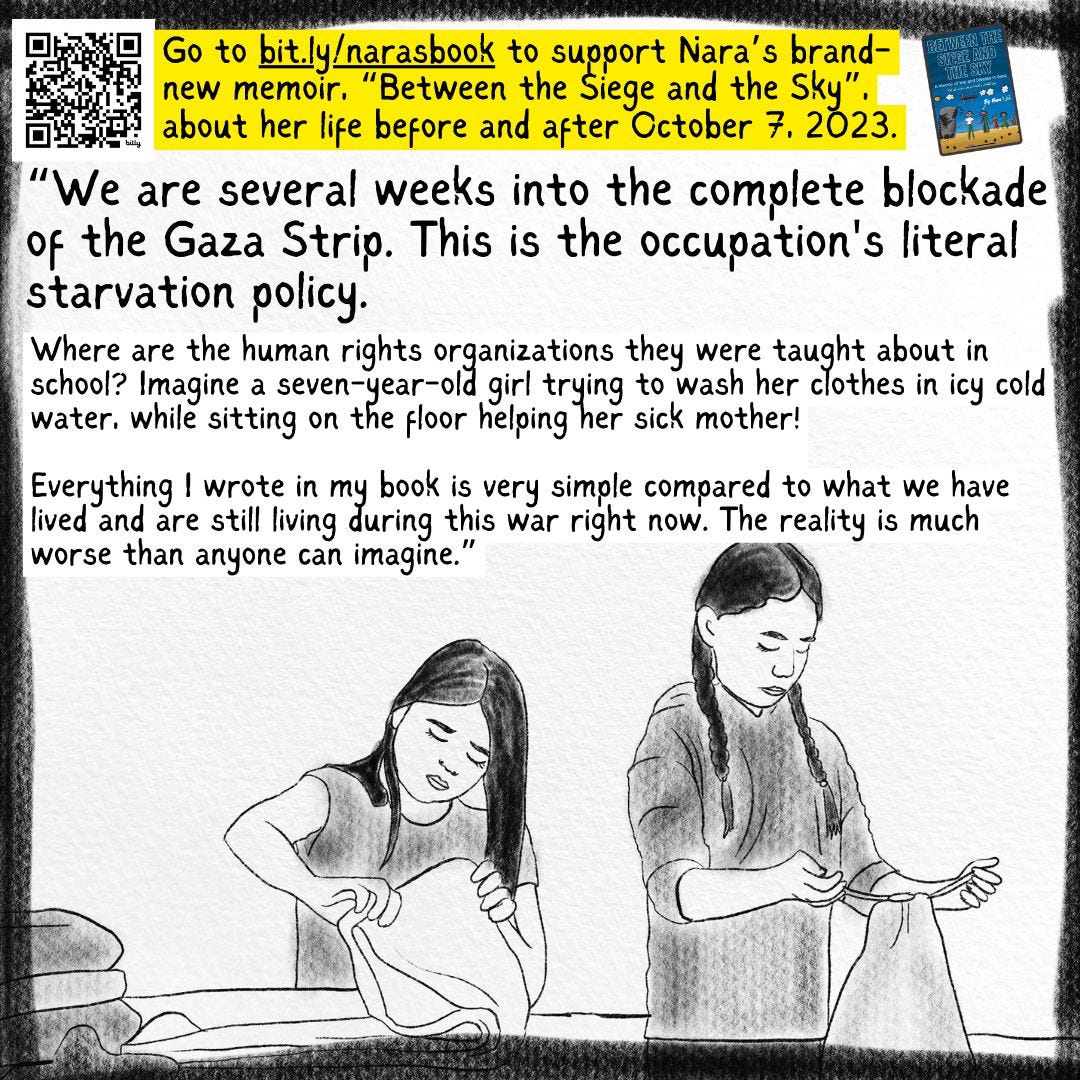Happy belated Spring Equinox. If you've been following along, you'll know that I've been aligning my sense of time with the Chinese solar calendar. In Mandarin, the Spring Equinox is known as 春分 (Chunfen).
The accuracy of the calendar I use never fails to amaze me. I love the little poem that accompanies this solar term:
The Yuan bird arrives. Thunder sounds. Lightning begins.
That is exactly what happened the moment we hit Spring Equinox, here in Tbilisi, Georgia. We had a cold spell and days of non-stop rain.
Since the Spring Equinox is when the sun is shining directly at the Earth's equator, there's this idea that it divides the day and night, cold and heat, Yin and Yang equally. So this is a time of balance. It is a time of seeking balance within your body and with the Land.
This is a great segue to what I want to dive into today, which is visioning an anti-capitalist, anti-white supremacy, decolonial and anti-ableist art practice. What does that look like for each of us?
I come from an art school background that was very much shaped by institutional validation. Now that I am rebuilding my studio practice, I find myself desiring new measures and strategies for “progress” and “success.” New metrics that do not lie within the art institution and the traditional art world.
Would you like to dream of them alongside me?
Building systemic change together
Big caveat, everything I'm about to talk about does NOT erase the fact that we still need systemic change on EVERY level to make art accessible to everyone.
We need serious systemic change to stop gatekeeping and fetishizing marginalized cultures in art spaces.
We need systemic change to make art making, art viewing, and art education actually accessible to disabled people.
We need systemic change to create an art world where artists do not have to commodify their artworks to survive.
Everything that I'm going to describe in today’s newsletter marks my own beginnings of working towards that systemic change, within my art studio, and eventually, the Rewilding Retreat I’ll be launching for disabled QTBIPOC folks this fall.
I want to co-create that anti-capitalist, anti-ableist creative space with everyone else who's there with me in the retreat. Because I do not have all the answers. No one can claim to know what an anti-capitalist, decolonized and anti-ableist art practice looks like. (Chances are, it looks beautifully different for everyone.) That's why we vision those worlds into existence in community.
So why this question, and why now?
When the body resists art
Last week, I had a few incredible days of art making. I thoroughly enjoyed myself because I was able to experiment with making clay from used coffee grounds and used tea leaves, which I molded into little pots.

It smells amazing to make clay from used coffee grounds and tea leaves. If you do not have sensory issues around the goopiness of clay, working with these materials is an absolute delight to the senses, and I highly recommend it. I am so excited to share this with my co-creators in the Rewilding Retreat.

I didn't notice it at the time, but as someone with hypermobile Ehlers Danlos Syndrome, I was starting to experience aches and pains. You see, I tend to hyper fixate on a new project until it is done, at the expense of all these cues from my body to take a break, tend to the pain, and maybe leave the rest of these tasks for another day.
I didn't fully get this message from my body until later last week, when I made vegetable inks from beetroot skins, onion skins and spinach.
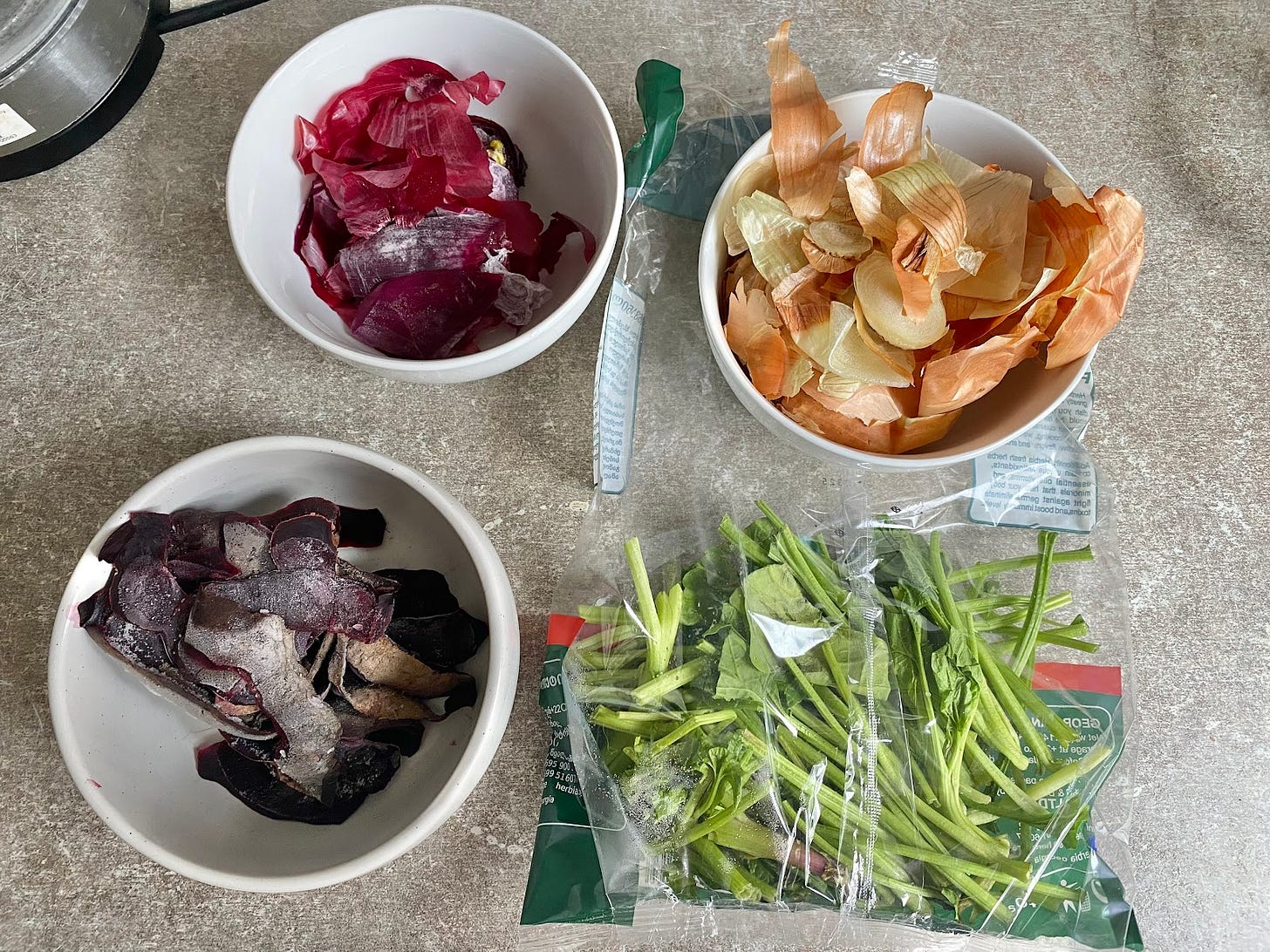
I probably could have just worked on a single ink for the day, but again, I hyperfocused.
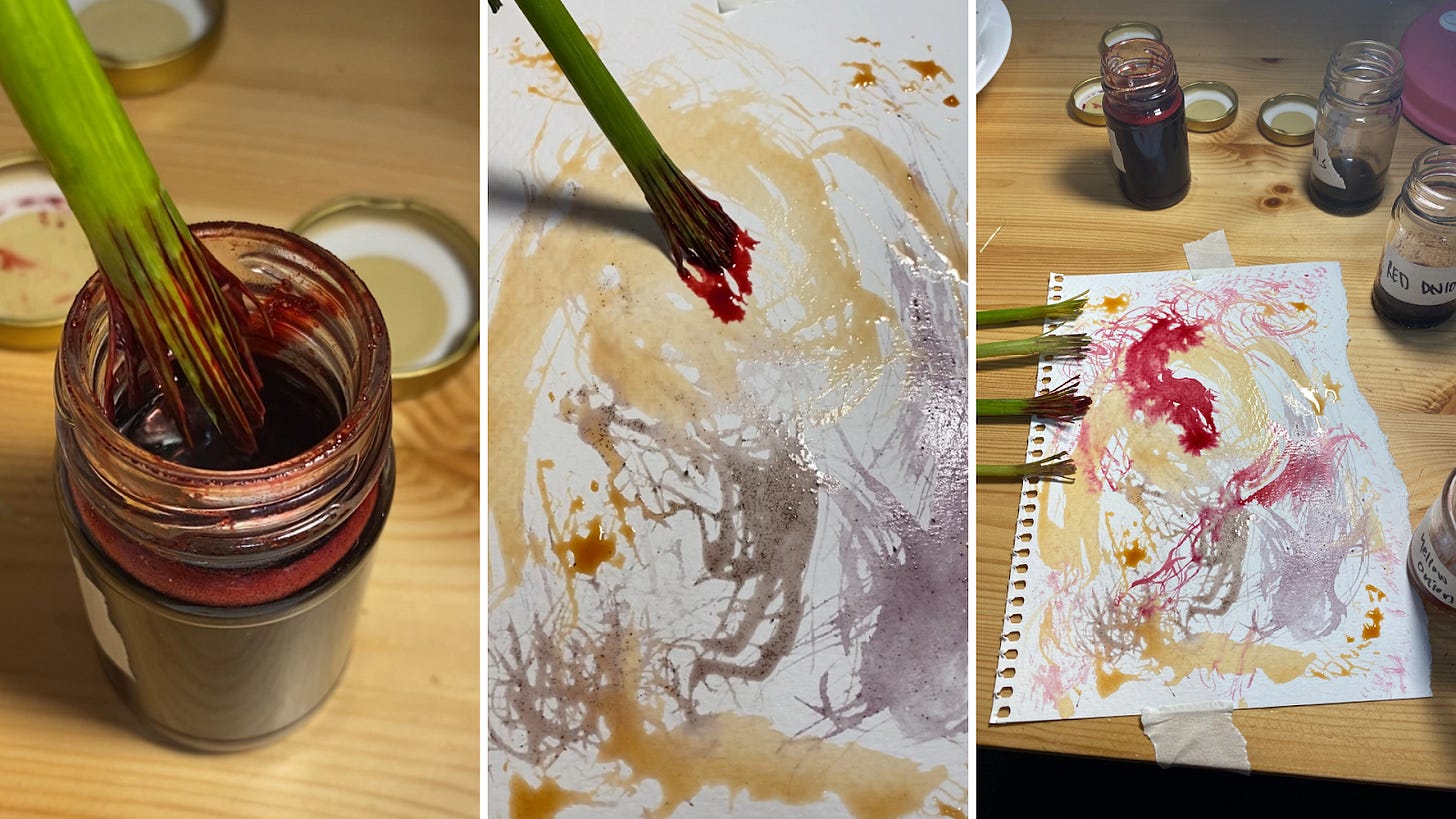
I constantly forget that my EDS has progressed over the years. Now I'm jumping back into my art practice as if no time has elapsed since I last was immersed in it in 2018. My body has changed a lot, and lots of movements are no longer accessible for me. Standing for hours was very harsh on my body, and I ended up with an enormous pain flare that took me out for the entire weekend.
It was a huge wake up call, because I want to make Rewilding Retreat as accessible as possible for everyone who joins. It's been great to rehearse, to pay attention and start thinking about, “Okay, if it's not accessible to me, how is it going to be accessible for everyone else?”
This brings me back to my question: “How do we create an art practice that is anti-capitalist, anti-ableist, and anti white supremacy culture?”
We need to practice differently
In art school, your success or your validity as an artist is defined by having a body of completed work. Your “authority” (I don’t believe in that word by the way) as an artist comes from the number of exhibitions you have under your belt, the number of grants you've had, the number of residencies you've done, and how many of your works are in museums, galleries, and private collections.
We desperately need alternatives to this traditional art practice model! I want and crave the alternative. So I thought of some alternatives. Some of them exist as questions. Some of them exist as practices that I've begun. Here they are in no particular order:
1. Let it stay an experiment
The first alternative I thought of was to simply let work exist as experiments and resist, resist, that urge to turn it into the final product.
For me, the final product means “this is exhibition-worthy.” You can display it in a white cube gallery, it looks presentable, it looks Instagram-worthy.
Of course, it’s okay if we do want to create a final “product,” but I would invite us to ask ourselves, “From what place am I creating this piece? Is it coming from a place of needing external validation, or is it because this is the natural conclusion of my experimental process?”
In the meantime, can we just let art exist as experiments and let that be valid?
Can we let each experiment serve its own purpose, for play, for expression, for healing, for so many other purposes that exist outside of capitalistic consumption?
2. Start a process journal
I’m hooked on this other strategy I've been working on, which I literally started yesterday. It’s focused on valuing process over product. I know people say that a lot, but how can we practice it beyond simply adopting a process-oriented attitude?
I suggest starting a process journal that you don’t show anyone unless you want to. Fill it up with what satisfies you, enjoy flipping through the pages of your journey, and letting that be enough.
I started a process journal in my iPad where I simply record my drawings, inspiration photos from nature, experiment photos, and notes. I’ve experienced full body YESes nonstop while jounralling because I was finally able to keep track of my thoughts, ideas, and next steps in one place. Before this, the photos would just live on my phone, and sure, I'll see them when I scroll through the albums, but I didn’t reflect on them or engage with them, which is such an important part of the creative process.
3. Structure within seasons
It can be disorienting to practice art without the traditional structures propping us up. I know that I personally don’t want to allow art institutions to dictate the themes, visuals, materials, or deadlines of the work that I create.
So I suggest working in a more rhythmic way, having topics that we explore based on seasons. For the season of spring, I've already noticed the theme of germination emerging in my work. I have been putting seeds in almost everything that I've been making.
For example, there are chia seeds in some of the coffee clay and tea clay pots I've made, and I plan to germinate those. I've also been making sheets of paper from used tea bags and embedding chia seeds in there.
Working this way, we’re allowing the Land guide and structure our creative practice. And if it turns out to be an insufficient container for the creative process, that's also fine. It's just a starting point and we get to decide where we go from there.
4. Measure resonance
What about having anti-capitalist metrics for your studio practice? I know the word “metrics” can sound very capitalistic and harsh, but really it's all about the substance of those metrics, isn't it? How do we track important values that aren't quantifiable?
This is inspired by the questions that
posed in their Seeda School retreat, where they talked about the importance of tracking moments of resonance as much as tracking other necessary business metrics.Some ideas:
How my body is feeling when I make art — do I feel a full body YES when I'm creating my artwork?
How does my energy feel? Do I feel depleted or nourished by creating this piece?
How has this artwork contributed to my emotional well being?
Did this artwork invoke new creative questions for me to explore?
Does this work have contribute to collective liberation? Does it contribute to community impact? Does it help the communities that we love and care about?
These are all wins we should be affirming ourselves for, yet we ignore them easily because capitalism, and because they're less tangible and a bit more abstract. They require you to really sit down, tune in to your body, and figure out, “Am I feeling depleted, or am I feeling nourished? Am I feeling a full body yes?”
I'm excited to see what happens if we spend an entire season devoted to tracking those moments instead of solely tracking the usual capitalist metrics, where the focus is on output, production, urgency. I'd be curious to see what shifts in our practice by focusing on an entirely different set of values.
5. Set intuitive goalsintentions
We could also set intentions that have nothing to do with quantifiable goals (e.g. “Create 3 sculptures by the end of the month.” Fuck SMART goals). I’m talking about intuitive, intangible, non-quantifiable intentions. For example:
We could set intentions around themes: “I want my artworks to embody the theme of germination this season.”
We can set intentions around materials: “This season, I want to explore working with seeds in my sculptures and paintings.”
We can set intentions around feelings: “I want today's art practice to invoke a sense of play” or “I want my art practice this week to deepen my sense of connection to the Land” or “I want to experience a sense of ritual in my art practice this week.”
Once again, this is a more intuitive, embodied way of checking in with ourselves. It requires us to tune in fully to see if we are aligning with our artistic intentions, or if our intention needs to change.
I'm in favor of anything that forces us to slow down, listen to ourselves, listen to the Land, and listen to the material that's in our hands.
6. Bring your body along
As I mentioned earlier, when I hyperfocus on a project just to get it done, I often forget to bring my body along. And after the pain flare last week, I've been trying my best to make sure that I am in my body before I work on my projects.
What body-based practices help you ground yourself? Let me know in the comments.
The somatic work that I find most helpful is Qigong. It has been an amazing movement practice for me. I feel deeply connected to the Land and my ancestors when I practice it. The videos I use regularly remind me to feel the Qi (energy) flowing through my body.
It's from this state of greater somatic awareness that I want to begin my art practice each day. Now, when I notice the pain, I stop whatever I'm doing and I get up and tend to the pain, whether it's using my massage roller or taking a hot shower.
7. Partner with the pain
As a disabled person, I recognize my physical pain is always going to be there and I’ve decided to make it a partner in my practice. It's not ideal. I have often felt very indignant that this is the body that I live in and other people get to do all kinds of exciting things with their bodies, like rock climbing or Muay Thai. I did those sports when I was younger and more stubborn, only to get very injured and find out that those were the worst sports for a person with hypermobility.
But really, the pain is my partner.
When I hurt the wrist of my dominant hand recently, I came face to face with the fact that avoiding physical therapy could mean that one day, I can't make the work that I love anymore. I received the message that physical therapy is going to be an important, non-negotiable part of my art practice.
Every creative person is going to have major physical access needs to tend to, to make their practice viable. What do you think yours might be?
8. Rest and receive
The pain flare was also a huge cry for help from my body to slow down.
Well, message received.
I had to fight off the everpresent inner critic and internalized capitalism as I rested for several days.
Then… something incredible and unexpected happened. It’s almost a cliché.
When Monday came round, my brain was flooded with new, fresh ideas I had for my art practice. Ideas for new things to make, new experiments to try.
When I left the house for a short while to run some errands, nearly every tree or plant I saw along the way prompted a new idea. I had to stop every few paces and record everything in my phone.
None of this would have been possible without rest.
I love how in Rest is Resistance, Tricia Hersey talks about the idea of receiving creative downloads from our ancestors when we're resting.
These downloads are so precious. And of course, when we try to rest, the voice of internalized capitalism fights to keep us from receiving those downloads, receiving the kind of wisdom that has the power to upend oppressive systems. Of course.
But when we do give ourselves the gift of rest?
God, it can be so beautiful.
To the Land, the Body, the Ancestors,
TQ
Help my friend Nara’s family survive genocide!
🚨Go to tinyurl.com/disablednara to support Nara, a 34yo Pal mom with multiple sclerosis and pancreatic cancer now!
🚨You can also go to bit.ly/narasbook to support Nara’s brand-new memoir, “Between the Siege and the Sky”, about her life before and after October 7, 2023.
Nara in her own words:
“My kids have aged a thousand years beyond their real ages of 13 and 7.
My kids are living in conditions of war and conflict between parties that have nothing to do with them or anything that's happening here. Neither of them understands what the word “war” means!
My kids haven't watched TV since the end of 2023, or gone to playgrounds. They've forgotten the word "games". A piece of clean bread or fresh fruit has become their greatest wish. How lucky would either one of them feel if she even had a piece of white meat.
“We are several weeks into the complete blockade of the Gaza Strip. This is the occupation’s literal starvation policy.
Where are the human rights organizations they were taught about in school? Imagine a seven-year-old girl trying to wash her clothes in icy cold water, while sitting on the floor helping her sick mother!
Everything I wrote in my book is very simple compared to what we have lived and are still living during this war right now. The reality is much worse than anyone can imagine.”
🚨Go to tinyurl.com/disablednara or bit.ly/narasbook to support Nara’s family now!
Image Description:
Begin image description: The text and links in both slides is the same as in the caption.
ID1: A black and white drawing of Nara in a headscarf with her arms wrapped around her older child, Jamila, who has long hair and is wearing a hoodie vest, and Jenan, who also has long hair and is wearing a t-shirt. Nara has a beseeching look on her face, while her kids are both looking down sadly.
ID2: A black and white drawing of Jamila and Jenan doing chores. 7-year-old Jenan is helping Nara with laundry with a somber look on her face and her straight hair down. 13-year-old Jamila is helping to take out the trash. She has her hair in two braids. She is also looking down with a serious look on her face. End image description.

